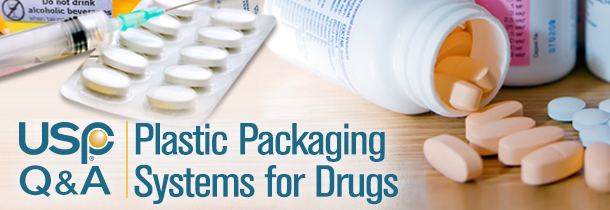
Q: What types of “plastic packaging systems” are used in the pharmaceutical industry?
A: Plastic packaging systems for pharmaceutical use include bags, bottles, vials, cartridges, metered-dose inhalers, prefillable syringes, pouches and closures for capsules and tablets. Plastic materials commonly used in these systems include polyethylene, polypropylene, polyolefins, and polyvinyl chloride, among others.
Plastic packaging systems can include—not only the container that holds a particular drug product—but also gaskets, rubber stoppers, tubing and other components that may be part of the overall system used to store and/or deliver a drug to the patient.
Q: What are the key quality considerations for manufacturers of plastic packaging systems for drug products?
A: As drug products are manufactured, packaged, and stored, they come into direct contact with packaging systems and their plastic materials of construction. Such contact may result in interactions between the drug product and its packaging system. The packaging systems must protect and be compatible with drug products and not compromise their stability, efficacy or safety. In turn, the ingredients of a drug product should not be absorbed onto the surface or migrate into the body of the plastic packaging system.
The use of well-characterized plastic materials of construction and the appropriate testing of packaging systems help to determine if adverse interactions are taking place. Manufacturers should be able to provide a rationale for using a particular raw material of a packaging system and characterize that material to know what can possibly come out of it (e.g., additives, extractable metals). This is key to determining potential interactions with a drug product.
Q: What are extractables and leachables?
A: Extractables are organic and inorganic chemical compounds that can be extracted from packaging material under laboratory conditions. They can be released from a pharmaceutical packaging/delivery system, a packaging component or a packaging material of construction. Depending on the specific purpose of a particular extraction study, laboratory conditions (e.g., solvent, temperature) may accelerate or exaggerate the normal conditions of storage and use for a packaged dosage form. Extractables themselves (or substances derived from extractables) have the potential to leach into a drug product under normal conditions or storage and use and, thus, become leachables.
Leachables are extractables derived from drug packaging or delivery systems that may migrate into the drug product over the course of a drug product’s shelf life. Leachables can affect the stability and efficacy of the drug product, and in some extreme cases, introduce some patient safety risks.
Q: How can USP help?
A: The U.S. Pharmacopeial Convention (USP) is a nonprofit scientific organization that develops and revises public standards that help promote global drug quality. USP’s standards encompass drug substances, excipients, drug products and their delivery and packaging systems. These standards are available for use by industry, academia, regulators, healthcare professionals and other stakeholders.
USP’s published official standards—in the form of specifications for identity, strength, quality and purity in drug product, drug substance and excipient monographs as well as information and procedures in general chapters—appear in the compendia, U.S. Pharmacopeia—National Formulary (USP–NF).
Q: What USP standards are available to support work with plastic packaging systems, as well as extractables and leachables?
A: USP has developed the following standards specifically for plastic packaging systems:
- General Chapter <661> Plastic Packaging Systems and their Materials of Construction: Testing rationale for plastic materials of construction and packaging systems used in the pharmaceutical industry. The use of well-characterized materials to construct a packaging system is a primary means of ensuring that the packaging system is suitable for its intended use since properties and characteristics of the materials can be matched to the performance requirements of the packaging system. (Current official standard, published in USP 38–NF 33.)
- General Chapter <661.1> Plastic Materials of Construction: Tests, procedures and acceptance criteria for plastic materials of construction used in pharmaceutical packaging systems. Proper characterization of materials of construction facilitates the identification of and use of appropriate materials for pharmaceutical packaging systems. (New standard, becomes official May 1, 2016, published in USP 39–NF 34.)
- General Chapter <661.2> Plastic Packaging Systems for Pharmaceutical Use: Safety aspects of a drug product’s packaging system based on appropriate chemical assessments, includes performing extractables testing, leachables testing, and toxicology assessment. (New standard, becomes official May 1, 2016, published in USP 39–NF 34.)
- General Chapter <1663> Assessment of Extractables Associated with Pharmaceutical Packaging/Delivery Systems*: Framework for the design, justification and execution of an extractables assessment for pharmaceutical packaging and delivery systems. Establishes critical dimensions of an extractables assessment and discusses practical and technical aspects of each. Also examines critical dimensions of an extraction study—laboratory generation of the extract (extraction) and testing the extract (characterization). (Current official standard, published in USP 38–NF 33, S1.)
- General Chapter <1664> Assessment of Drug Product Leachables Associated with Pharmaceutical Packaging/Delivery Systems*: Framework for the design, justification and implementation of assessments for drug-product leachables derived from pharmaceutical packaging and delivery systems. Covers: 1) the requirement for leachables studies; 2) fundamental concepts for leachables studies; 3) the basis of thresholds for leachables and general guidance and application of these thresholds; 4) design and implementation of leachables studies; 5) leachables method development and validation; 6) correlation of results from extractables assessment and routine extractables testing with leachables studies; and 7) establishment of leachables specification including acceptance criteria. (Current official standard, published in USP 38–NF 33, S1.)
*This chapter is for informational purposes, it does not establish specific conditions, analytical methods, specifications, or acceptance criteria for any particular dosage forms or packaging system or drug product combination. The principles and best practices outlined in this general chapter represent a unified interpretation of sound science and are applicable to situations in which extractables or leachables assessment is required for pharmaceutical application.
Q: Does USP have plans to develop future standards for plastic packaging systems?
A: Yes, USP is currently developing a brand new chapter <661.3> Plastic Materials for Pharmaceutical Manufacturing Systems which will cover plastic components and systems used in the manufacturing of a drug products. The chapter is scheduled to be published for public review and comment in Pharmacopeial Forum 42 (3) May 2016.
In addition, we will be hosting a workshop June 20–21 on Material Biocompatibility and Standard for Plastic Manufacturing Systems/Components at our facility in Rockville, MD.
We encourage all interested parties to take advantage of these two new resources to learn more and contribute to the development of new USP standards for drug packaging systems.
For additional information or answers to questions about USP’s standards for plastic packaging systems, please contact Dr. Hunt at dgh@usp.org.

